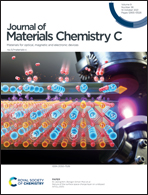Spatial regulation of electroplex emission via dendritic molecular engineering†
Abstract
An electroplex, the counterpart of an exciplex, mainly occurs in an electric field and has been attracting the attention of researchers to explore and study its properties and applications in electroluminescent devices. In this work, we designed an efficient way to control the electroplex emission using dendritic molecular engineering. Increasing the peripheral alkyl-chain carbazole groups can not only inhibit the formation of electromers effectively but can also regulate the distance between the donor and acceptor molecules. Thus, it provides an effective strategy to study the formation mechanism of exciplexes and electroplexes via dendritic molecular engineering. Remarkably, TCTA-O-CZ and TCTA-O-2CZ demonstrate different photophysical and electroluminescent properties when blended with PhPO. The TCTA-O-CZ:PhPO mixture exhibits a new photoluminescence (PL) emission peak at 450 nm and an electroluminescence (EL) emission peak at 480 nm, which correspond to the exciplex and electroplex emissions, respectively. However, TCTA-O-2CZ shows only the electroplex emission at 480 nm under electrical excitation, which indicates that the electroplex features a long-range charge-transfer process. In addition, the electromer emission peaks at long wavelengths are also suppressed to a large extent. Thus, the spatial regulation between the donor and acceptor molecules seriously influences the formation of the exciplex, electromer and electroplex. Finally, solution-processed blue phosphorescence OLEDs (PHOLEDs) were fabricated using TCTA-O-CZ:PhPO and TCTA-O-2CZ:PhPO as the host and FIrpic as the guest. These devices, based on the TCTA-O-CZ:PhPO host (Device D) and TCTA-O-2CZ:PhPO host (Device E), show good performances with turn-on voltages of 4.2 V and 5.1 V, and current efficiencies of 17.1 cd A−1 and 9.6 cd A−1, respectively. The lower efficiency roll-off of Device E based on the TCTA-O-2CZ:PhPO host indicates that efficient encapsulation via dendritic molecular engineering can suppress the electromer emission and energy leakage.



 Please wait while we load your content...
Please wait while we load your content...